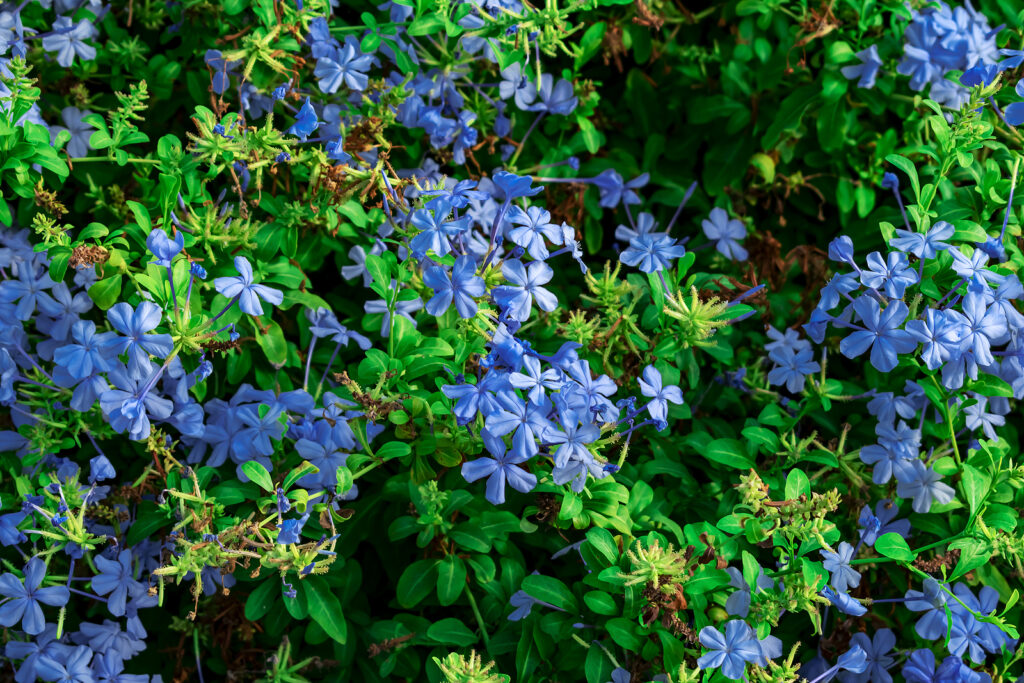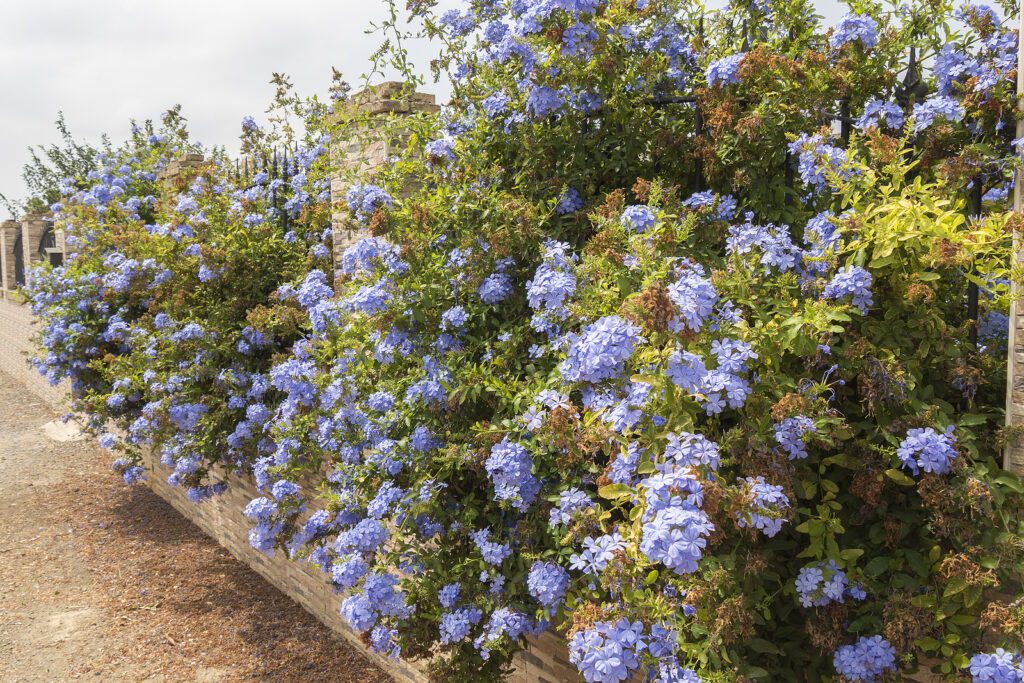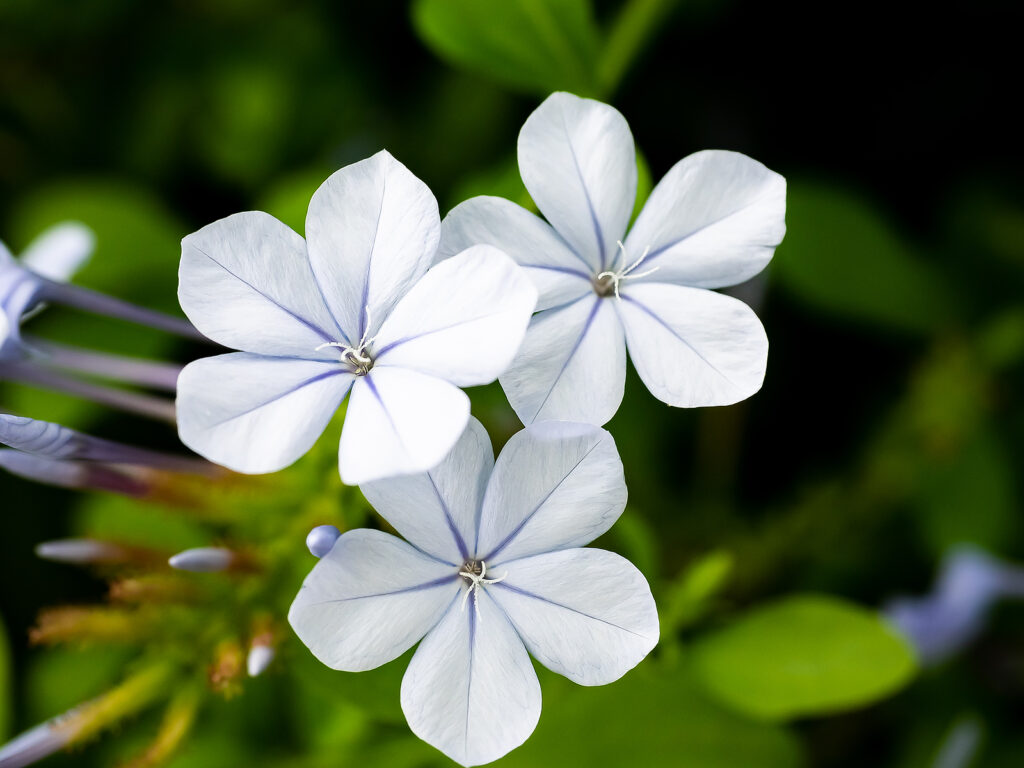Plumbago– commonly called cape plumbago–is a fast-growing, long-flowering sprawling shrub or vine. It produces abundant sprays of pale, sky blue flowers from summer into autumn.
Cape Plumbago produces whip-like shoots that can be trained to support as a vine. This plant tolerates salty, calcareous, and rocky soil. It is a good choice for banks and hot and dry spots. It is drought-tolerant once established, but with some supplemental water, it will grow full.
Flowers are an inch wide and appear on phlox-like clusters. The flower color may vary from plant to plant and is set for life, so it is a good idea to purchase the plant in bloom to know what you are getting.
This plant is not to be confused with Dwarf Plumbago, Ceratostigma plumbaginoides, which grow to one-third the size of Cape Plumbago and is used as a groundcover.
Plumbago is a genus of about 15 species of annuals, perennials, and evergreen shrubs native to warm-temperature to tropical regions worldwide.

Get to know Cape Plumbago
- Plant type: Evergreen to semi-evergreen shrub or vine
- Growing zones and range: Zones 9 to 10
- Hardiness: Frost will blacken and kill leaves and damage growth tips, but the plant usually recovers.
- Height and width: 6 feet (1.8m) tall, 8 to 10 feet (2.4-3m) wide; with support plant can be trained to 12 feet (3.6m) high.
- Foliage: Light to medium green leaves 1 to 2 inches (2.5-5cm) long are elliptic or oval-shaped.
- Flowers: White to light blue flowers 1-inch wide in phlox-like clusters; flower color is fixed and varies from plant to plant; if color is important, purchase plants in bloom.
- Bloom time: Spring to fall; year-round in frost-free regions.
- Uses: Good background and filler plant; use to cover bank, fence, or hot-wall; can withstand salt spray.
- Common name: Cape Plumbago, leadwort
- Botanical name: Plumbago auriculata (P. capensis)
- Family name: Plumbaginaceae
- Origin: South Africa

Where to plant Cape Plumbago
- Plant Cape Plumbago in full sun.
- Plant Cape Plumbago in average to humus-rich, well-drained soil.
- Where frost may occur, plant against a south-facing wall.
- In cold winter regions, plant in pots that can be brought into a sunroom in winter.
When to plant Cape Plumbago
- Set container-grown plant in the garden in spring after all danger of frost is past.
Planting and spacing Cape Plumbago
- Space plants 8 to 10 feet (2.4-3m); a bit closer if growing as an informal hedge.

How to water and feed Cape Plumbago
- Keep the soil evenly moist; once established plants can tolerate some drought, however, supplemental watering will keep the plant full.
- Fertilize Cape Plumbago in spring with an all-purpose fertilizer.
Cape Plumbago care
- Mulch around plants to conserve soil moisture.
- Young growth blackens and leaves drop in heavy frosts. Prune out damaged growth after frost danger is past.
- If growing upward, tie selected shoots to supports.
- Move conservatory plants onto the patio in summer and indoors in autumn.
Grow Plumbago as a houseplant
- Grow Plumbago in average to warm temperature, direct light, and average humidity.
- In winter, the temperature should be cool.
- the medium should be soilless, well-drained, and kept evenly moist at all times in spring, summer, and allow. All the medium to dry slightly between watering in winter.
- Fertilize once a month in spring and summer.
- Prune the plants in winter before new growth starts, and use the prunings to root new plants.
Cape Plumbago pests and diseases
- Whitefly may be a problem if grown in a greenhouse.
Cape Plumbago propagation
- Take semi-ripe cuttings in summer.

Cape Plumbago varieties to grow
- Plumbago auriculata (formerly P. capensis). Grows to 5 feet (1.5m) tall and wide in five years; ultimately grows to 10 feet tall and 13 feet wide; terminal clusters of slender-tubed, sky-blue flowers a half-inch or more across in summer to early winter. Cultivar ‘Alba’ has pure white flowers.















